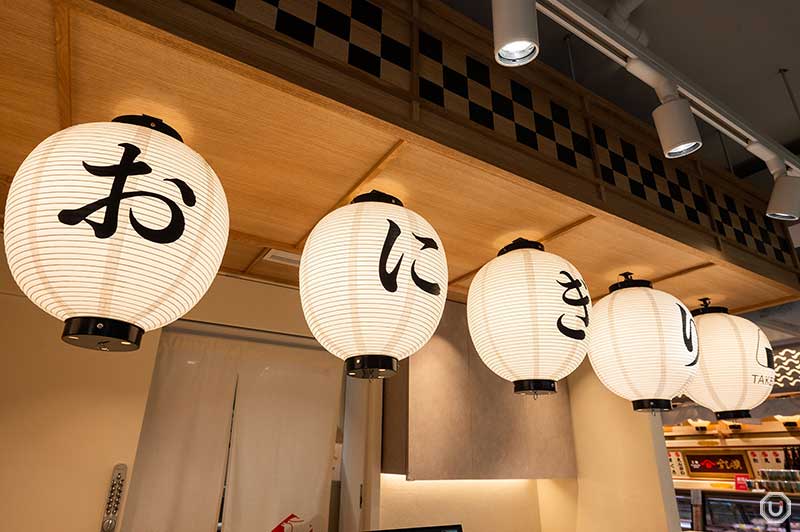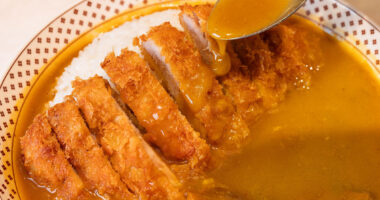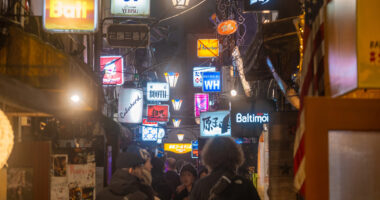Ochazuke has long been loved in Japan as somewhat of a fast food. It’s a simple and easy dish made by pouring tea or dashi broth over a bowl of white rice.
However, a visit to “Ochazuke Onigiri Yamamotoyama” located in the EATo LUMINE complex inside JR Shinjuku Station is bound to change your image of the simple dish.
While maintaining the dish’s convenient aspect, you’ll discover higher-grade types of ochazuke with carefully selected ingredients at the restauirant.

Dashi broth that reflects the commitment of a long-established shop
Ochazuke Onigiri Yamamotoyama is run by Yamamotoyama, a company founded in 1690. Known for selling tea and nori seaweed, Yamamotoyama is one of Japan’s most renowned long-established businesses. With such a long history, they have stringent standards for selecting ingredients and are committed to quality.

Ochazuke Onigiri Yamamotoyama’s exterior
For their ochazuke, they use a unique blend of “tea dashi” made from hōjicha (roasted green tea). The broth is prepared by blending dashi made from carefully selected bonito, kombu, and shiitake, which is steeped overnight.

“Tea dashi”
In the “firing” process that dries and enhances the flavor of tea leaves, the stems and leaves of the hojicha are processed separately.
This results in a hojicha without harshness that retains its flavor even when combined with dashi.
There’s a particular reason for using bonito, kombu, and shiitake in the dashi. Combining three different umami components adds a richer depth to the tea dashi.

This carefully crafted tea dashi, a specialty of this long-established tea merchant from the Edo period, is available for refills.
You can even enjoy the tea dashi on its own to savor its rich flavor and umami.
Unique toppings to pair with the tea dashi
It’s surprising how well the tea dashi pairs with all the toppings offered at Ochazuke Onigiri Yamamotoyama.
One example of that is the “Roast Beef Chazuke.”

“ローストビーフ茶漬け,” Roast Beef Chazuke 1,500 JPY (tax included)
The lean beef used for the roast beef is simply seasoned with just salt and pepper.
The roast beef itself is of such high quality and can be deliciously eaten as a roast beef bowl without adding the tea dashi.

Adding the tea dashi transforms the flavor, greatly enhancing the richness of the gravy sauce.

Yet the aftertaste remains clean thanks to the hojicha-based tea dashi.
Ochazuke using tuna, a staple of Japanese flavors
In addition to the Western-style roast beef ochazuke, there is also a tuna ochazuke that reflects Japanese tradition.
Ochazuke Onigiri Yamamotoyama offers a “Tsuke-Maguro (Marinated Tuna) Chazuke”, with a twist on tuna.

“漬けマグロ茶漬け,” Tsuke-Maguro (Marinated Tuna) Chazuke 1,350 JPY (tax included)
The marinade for the tuna is based on white soy sauce. The restaurant adjusts the proportion of seasonings and marinating time daily to avoid it becoming too salty.
White soy sauce, with its pale amber hue, is used to preserve the natural color of the tuna, allowing it to shine through.

Paying attention to the appearance of the dish as much as its taste just makes it all the more delicious.
Such meticulous attention to detail is characteristic of a long-established shop such as this.
Onigiri rice balls featuring high quality nori seaweed for takeout
Besides ochazuke, Ochazuke Onigiri Yamamotoyama specializes in onigiri (rice balls) with twelve different fillings, available for takeout.

You can also dine in, with freshly made “Onigiri Rice Ball Sets” available. These sets allow you to choose two fillings from the twelve options.

“おにぎりセット,” Onigiri Rice Ball Set 680 JPY (tax included)
There are two unique fillings only available at Ochazuke Onigiri Yamamotoyama. First is the “Yamamotoyama Nori-Seaweed Tsukudani Paste x White Small Fish with Japanese Peppercorn.”
The rice balls use “Norino,” a seaweed tsukudani (seaweed simmered in soy sauce) sold by Yamamotoyama.
Norino has a notable rich sweetness and good aroma, filling your mouth with the authentic flavor of nori.
When combined with the chirimen sanshō (the small white fish and Japanese peppercorn in the name), it provides a refreshing aftertaste.
As Norino is quite sweet, it mellows the spiciness of the chirimen sansho.

“のりの×ちりめん山椒,” Yamamotoyama Nori-Seaweed Tsukudani Paste x White Small Fish with Japanese Peppercorn, take-out: 330 JPY à la carte (tax included)
The second of these store-exclusive rice balls is the “Yamamotoyama Nori-Seaweed Tsukudani Paste x Plum Chips,” which also uses Norino.
The ume (plum) chips have an exquisite crispy texture, creating a textural contrast with the smoothness of the Norino.
The sourness of the ume chips and the sweetness of the Norino complement each other particularly well.

“のりの×梅チップ,” Yamamotoyama Nori-Seaweed Tsukudani Paste x Plum Chips, take-out: 330 JPY à la carte (tax included)
Ochazuke Onigiri Yamamotoyama: a tea merchant’s commitment since the Edo Period
Yamamotoyama continues to provide new value for nori seaweed and tea both domestically and internationally without being bound by tradition.
At its core is the desire to “propose new ways to enjoy delicious tea and nori seaweed.” This sentiment is very evident in the deliciously designed menu and store design of Ochazuke Onigiri Yamamotoyama!

If not using a train, an entrance ticket of 150 JPY (tax included) is required to enter the station
Information
| Store name | お茶漬けおにぎり 山本山 Ochazuke Onigiri Yamamotoyama |
|---|---|
| Address | Inside the ticket gates of JR Shinjuku Station (west ticket gate direction), 3-38 Shinjuku, Shinjuku-ku, Tokyo B1F
|
| Access |
Shinjuku Station(SJK) Within Shinjuku Station
|
| Phone number | Unlisted |
| Reservations | Not accepted |
| Payment |
|
| Service charge/Table charge | None |
| Hours | Take-out 7:00-23:00 Dine-in 8:00-23:00(last order 22:00) |
| Closed | No holidays excluding EATo LUMINE holidays |
| Seating | 10 counter seats |
| Smoking | All seats are non-smoking |
| Official website | https://www.yamamotoyama.co.jp/ |
| Other information |
|
※Menu contents, prices, store information, etc. are current as of June 2024.












